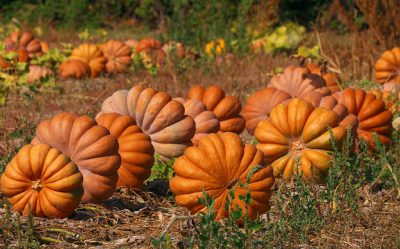Autumn Challenge: Picking a Perfect Pumpkin!
A Little Pumpkin History…
Picking a perfect pumpkin is a lot of fun, but did you know the pumpkin has a long and storied history? The American word “pumpkin” originated from the Greek word ‘Pepon’, which means large melon. The word gradually changed through the years by the French, English, and then Americans to the pumpkin we know today. It is believed that pumpkins and squash originated in ancient America, even before the prevalent use of corn. Based on early documents, it appears that pumpkins were a major source of survival for the Pilgrims, especially during the winter months. Pumpkins were first documented as served at the second Thanksgiving celebration.
There are multiple theories as to the origins of what we now know as jack-o-lanterns and our modern Halloween celebrations. Early jack-o-lanterns from the Irish and Scottish were actually carved from potatoes and turnips for their Celtic celebrations. The English used beets and added lit lumps of coal inside the hollowed-out vegetables. As the European immigrants settled in to America, the tradition transitioned to the better-suited pumpkins.
Pumpkin Pickin’ Tips
The weather has made for a good pumpkin year this year. So whether you want to pick your own right off the vine, or if you’re going to pick one from a pile, here are a few tips for finding that perfect pumpkin!
- Lift it up – a good pumpkin feels firm and heavy for it’s size.
- Check for a hard, sturdy stem. A green stem means it has just been freshly harvested.
- Make sure there are no soft spots, mold, or open cuts. Press on the bottom of the pumpkin with your thumbs. If it gives at all, your pumpkin is not fresh.
- Look for an even bottom so the pumpkin will stand upright and not roll on a flat surface.
- Color hue doesn’t necessarily matter – pumpkins will continue to ripen even after they are picked so the color will deepen. But choose a pumpkin with consistent coloring all around.
- Bumps don’t matter! The hardened bumps and bruises that can sometimes be found on pumpkins and gourds do not affect the pumpkin and just add a spooky effect if you should so choose.
- Hold off on carving – The pumpkin will start to rot about a week after it’s carved out, so hold off carving until closer to Halloween to keep your pumpkin looking spooky for the big day.
- Baking? Go for the smaller 4-6 pound pumpkins. These baking pumpkins have a better texture and taste than the more stringy and bitter carving pumpkins.
What’s With The Cinderella Pumpkins?
 I don’t know about you, but I’ve been seeing these “Cinderella” pumpkins everywhere lately. They are actually a French pumpkin with the real name of Rouge vif d’Etampes. They are commonly known as the Cinderella pumpkin because they look like the one in the popular fairy tale. But it is this type of pumpkin that was likely cultivated by the early Pilgrims and served during those first Thanksgiving celebrations. They are great for decorations but also have a good flavor for a pie or any winter squash recipe.
I don’t know about you, but I’ve been seeing these “Cinderella” pumpkins everywhere lately. They are actually a French pumpkin with the real name of Rouge vif d’Etampes. They are commonly known as the Cinderella pumpkin because they look like the one in the popular fairy tale. But it is this type of pumpkin that was likely cultivated by the early Pilgrims and served during those first Thanksgiving celebrations. They are great for decorations but also have a good flavor for a pie or any winter squash recipe.
Want to learn more about the different types of pumpkins and how to use them? Check out All About Pumpkins for some quick tips.
Looking for ideas for an extreme pumpkin? Take a look at these extreme pumpkin carvings.
Time to Choose Your Own Pumpkin?
Here are a few places close by:
- Garden Time, 652 Quaker Road, Queensbury
- Mead’s Nursery & Garden Center, 361 Ridge Road, Queensbury
- Ryan’s Country Farm, 955 State Route 149, Lake George
- Northland Gardens, 423 West Mountain Road, Queensbury
- Hewitt’s, 294 Quaker Road, Queensbury
- Binley Florist & Garden Center, 773 Quaker Road, Glens Falls
- Home Depot, 820 Route 9, Queensbury
Want to Pick Your Own Right From the Vine?
Try:
- Kelly’s Emerald Feeds, 672 County Line Road, Queensbury
- It’s About Thyme Farm, 32 Smith Road, Olmstedville




